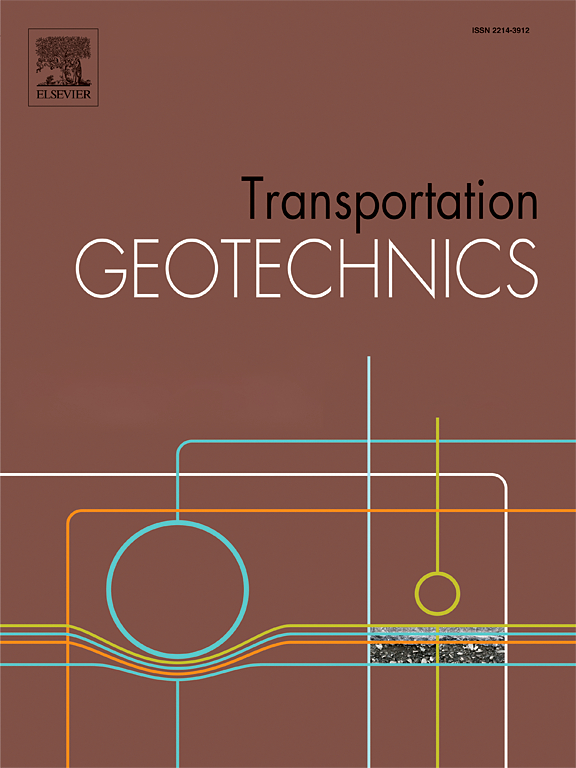传统稳定剂、再生稳定剂和可持续稳定剂对未处理土壤和已处理土壤的动态特性的最新评述
IF 4.9
2区 工程技术
Q1 ENGINEERING, CIVIL
引用次数: 0
摘要
评估结构下方的地下地质条件至关重要,因为土壤在承受静态或动态荷载时会失去固有的晶间强度。施加动荷载会导致应力波在土壤中传播,从而导致土壤结构变形,造成比静荷载更严重的破坏。在使用石灰和水泥等传统添加剂处理粘土性质的动态特性方面,已经开展了大量研究。为了取得更好的效果并解决传统材料在土壤改良中的局限性,使用非传统稳定剂(被称为 "再生和可持续 "材料)的趋势日益明显。这些材料包括硅灰、聚丙烯纤维、钢渣、粉煤灰、橡胶轮胎颗粒、玄武岩、回收玻璃和碎玻璃等,目前正在对这些材料进行深入研究,以改善粘土的动力行为。这篇综述文章比较了传统稳定剂和可持续稳定剂对土壤动态工程特性的影响。文章还强调了使用此类材料的工程意义和创新之处。虽然传统稳定剂能有效提高土壤强度和耐久性,但它们也带来了环境挑战,包括二氧化碳排放量增加和地震应力下的脆性。创新的重点在于完善这些技术,并采用可持续的替代品,如废物衍生材料,以提高土壤性能、改善抗震性能并减少对环境的影响。本研究强调了为现代基础设施开发具有成本效益、生态友好型解决方案的必要性。研究系统地分析了近期有关使用这些添加剂稳定土壤的主题,研究了影响稳定粘土动态特性的参数。此外,报告还回顾了稳定化引起的微观结构变化及其对动态特性的影响,并对未来研究提出了建议。本文章由计算机程序翻译,如有差异,请以英文原文为准。
A state-of-the-art review on the dynamic characteristics of untreated and treated soils by traditional, recycled, and sustainable stabilizers
Assessing the subsurface geological conditions beneath a structure is crucial, as soils inherently tend to lose intergranular strength when subjected to static or dynamic loads. Applying dynamic loads can result in the propagation of stress waves through the soil, leading to deformation of the soil structure and causing more significant damage than static loads. Extensive research has been conducted on treating dynamic characteristics of clay soil properties using traditional additives such as lime and cement. To achieve better results and address the limitations of conventional materials in soil improvement, there is a growing trend towards using non-traditional stabilizers, referred to as ’recycled and sustainable’ materials. These include, for example, silica fume, polypropylene fibers, steel slag, fly ash, rubber tire particles, basalt, and recycled and crushed glass, which are currently being deeply investigated to improve the dynamic behavior of clay soils. The review article compares the effects of traditional and sustainable stabilizers on dynamic engineering properties of soils. It also highlights the engineering significance and innovations in the use of such materials. While traditional stabilizers effectively improve soil strength and durability, they pose environmental challenges, including increased CO2 emissions and brittleness under seismic stress. Innovations focus on refining these techniques and incorporating sustainable alternatives, such as waste-derived materials, to enhance soil properties, improve seismic performance, and reduce environmental impact. The study underscores the need for developing cost-effective, eco-friendly solutions for modern infrastructure. It systematically analyzes recent topics on soil stabilization using these additives, examining parameters that influence the dynamic properties of stabilized clay soils. Furthermore, it reviews microstructural changes due to stabilization and their impact on dynamic properties, offering suggestions for future research.
求助全文
通过发布文献求助,成功后即可免费获取论文全文。
去求助
来源期刊

Transportation Geotechnics
Social Sciences-Transportation
CiteScore
8.10
自引率
11.30%
发文量
194
审稿时长
51 days
期刊介绍:
Transportation Geotechnics is a journal dedicated to publishing high-quality, theoretical, and applied papers that cover all facets of geotechnics for transportation infrastructure such as roads, highways, railways, underground railways, airfields, and waterways. The journal places a special emphasis on case studies that present original work relevant to the sustainable construction of transportation infrastructure. The scope of topics it addresses includes the geotechnical properties of geomaterials for sustainable and rational design and construction, the behavior of compacted and stabilized geomaterials, the use of geosynthetics and reinforcement in constructed layers and interlayers, ground improvement and slope stability for transportation infrastructures, compaction technology and management, maintenance technology, the impact of climate, embankments for highways and high-speed trains, transition zones, dredging, underwater geotechnics for infrastructure purposes, and the modeling of multi-layered structures and supporting ground under dynamic and repeated loads.
 求助内容:
求助内容: 应助结果提醒方式:
应助结果提醒方式:


